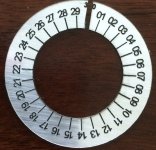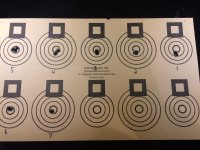Gene Beggs
Active member
Experienced benchresters will tell you that keeping the rifle in tune throughout the day as atmospheric conditions change is the biggest challenge the short-range group shooter faces. So, just what is it that makes the rifle go out of tune? Simple! The bullets begin to exit the muzzle at the wrong time. (usually too soon) Yep, it's that simple.
Let's say you have the rifle in perfect tune during the first match of the morning. As the day progresses temp steadily increases and by noon the rifle acts like it's broke! You say to yourself, 'Well, I guess I just missed a condition.' Maybe, maybe not. Maybe you just didn't make changes in the tune to compensate for the increase in temp. The air thinned out due to the increase in temp, bullets met with less atmospheric resistance as they accelerated down the bore and began to exit before the muzzle reached it's sweet spot just before the top of its swing.
Some of you are probably thinking, "Aw, horse manure Beggs, it can't be that simple." If you are one of those, don't read any further because I can't help you, but if you're one that enjoys the study of extreme rifle accuracy and desires to improve your standings in matches, listen up!
The question is; how do you compensate? Do you go up or down on the powder charge? If you have a tuner, do you go in or out? How much? Change seating depth? How 'bout changing powder and/or bullets? Curse and sling things all over the place? Bring out your spare rifle? Change scopes? Give up and go home? I assure you that during the last thirty years, I've tried all that and eventually learned what works and what doesn't. Once you get the rifle in tune during the first match of the morning, you can KEEP it in tune throughout the day with one or the other of the following methods: (But don't try to mix them up, you'll get hopelessly lost.)
1. Adjust the powder charge.
2. Make a tuner adjustment.
Among the top shooters there are two camps;
1. Those who tune ONLY with the powder charge.
2. Those (very few) that have learned to use a tuner and make adjustments ONLY with the tuner.
Keep in mind that here we are talking about short range group shooting at 100 and 200 yards with the 6PPC using N133, H322, LT32 etc., which is the only shooting discipline I know anything about.
Lets say you have a good shooting barrel and bullets that you know are accurate. Your favorite load is 30 grains of N133 and you have your bullets seated where you know they shoot. You go to the line and fire a fouler and a three shot test group. The group prints two bullet holes of vertical. Bummer, the rifle is completely out of tune. If you tune with the powder charge, go either up or down .6 grains and you will be real close. The sweet spots in the barrel's vibration pattern repeat at 1.2 grain (120 fps) intervals. Since 30 grains of N133 is right at the top of the upper tune window, I would prefer to go down .6 but,,,,aw 'ell, I'm not gonna try to tell you how to tune with the powder. Ask Tony Boyer, Charles Huckeba, Gene Bukys, Mike Conry, Jack Neary, Wayne Campbell etc., that's how they do it. Me? I prefer to use a tuner. I can make quick and easy adjustments at the line to compensate for changes in atmospheric conditions and never have to pull bullets and reduce the charge on rounds that are too hot.
I can just hear it now, moans in the background saying, "Oh man, here we go again,, tuners!" But wait! We have made lots of progress in recent years and I'm quite sure the centerfire benchrest community is in for a big awakening. Stay tuned!
Later and good shootin'!
Gene Beggs
02-06-18 Continuing,,,,
Without a doubt, the biggest question on everyone's mind is how do you keep the rifle in tune with a tuner once the in-tune position is found. Things will make a lot more sense once you understand how the barrel vibrates and how moving the tuner fore and aft raises and lowers the vibration frequency. Do not be discouraged by charts, animations and complicated technical data describing various vibration modes etc. It's not that complicated and I'll tell you how to demonstrate it.
Take a cleaning rod, hold it by the handle and extend it horizontally. Now take the heel of your other hand or a small mallet and strike the the handle as if you were trying to drive the rod into something. You will notice that the rod humps up in the middle and the tip flips downward setting up a vibration pattern that makes the tip wave up and down. That's exactly what happens to your rifle barrel. Each barrel has its own vibration characteristics and frequency due to the length, diameter, profile etc., and that's fixed, but if we install a weight that can be moved fore and aft we can vary the vibration frequency so bullet exit occurs just at the right moment as the muzzle approaches the top of its upward swing.
To be continued,
Let's say you have the rifle in perfect tune during the first match of the morning. As the day progresses temp steadily increases and by noon the rifle acts like it's broke! You say to yourself, 'Well, I guess I just missed a condition.' Maybe, maybe not. Maybe you just didn't make changes in the tune to compensate for the increase in temp. The air thinned out due to the increase in temp, bullets met with less atmospheric resistance as they accelerated down the bore and began to exit before the muzzle reached it's sweet spot just before the top of its swing.
Some of you are probably thinking, "Aw, horse manure Beggs, it can't be that simple." If you are one of those, don't read any further because I can't help you, but if you're one that enjoys the study of extreme rifle accuracy and desires to improve your standings in matches, listen up!
The question is; how do you compensate? Do you go up or down on the powder charge? If you have a tuner, do you go in or out? How much? Change seating depth? How 'bout changing powder and/or bullets? Curse and sling things all over the place? Bring out your spare rifle? Change scopes? Give up and go home? I assure you that during the last thirty years, I've tried all that and eventually learned what works and what doesn't. Once you get the rifle in tune during the first match of the morning, you can KEEP it in tune throughout the day with one or the other of the following methods: (But don't try to mix them up, you'll get hopelessly lost.)
1. Adjust the powder charge.
2. Make a tuner adjustment.
Among the top shooters there are two camps;
1. Those who tune ONLY with the powder charge.
2. Those (very few) that have learned to use a tuner and make adjustments ONLY with the tuner.
Keep in mind that here we are talking about short range group shooting at 100 and 200 yards with the 6PPC using N133, H322, LT32 etc., which is the only shooting discipline I know anything about.
Lets say you have a good shooting barrel and bullets that you know are accurate. Your favorite load is 30 grains of N133 and you have your bullets seated where you know they shoot. You go to the line and fire a fouler and a three shot test group. The group prints two bullet holes of vertical. Bummer, the rifle is completely out of tune. If you tune with the powder charge, go either up or down .6 grains and you will be real close. The sweet spots in the barrel's vibration pattern repeat at 1.2 grain (120 fps) intervals. Since 30 grains of N133 is right at the top of the upper tune window, I would prefer to go down .6 but,,,,aw 'ell, I'm not gonna try to tell you how to tune with the powder. Ask Tony Boyer, Charles Huckeba, Gene Bukys, Mike Conry, Jack Neary, Wayne Campbell etc., that's how they do it. Me? I prefer to use a tuner. I can make quick and easy adjustments at the line to compensate for changes in atmospheric conditions and never have to pull bullets and reduce the charge on rounds that are too hot.
I can just hear it now, moans in the background saying, "Oh man, here we go again,, tuners!" But wait! We have made lots of progress in recent years and I'm quite sure the centerfire benchrest community is in for a big awakening. Stay tuned!
Later and good shootin'!
Gene Beggs
02-06-18 Continuing,,,,
Without a doubt, the biggest question on everyone's mind is how do you keep the rifle in tune with a tuner once the in-tune position is found. Things will make a lot more sense once you understand how the barrel vibrates and how moving the tuner fore and aft raises and lowers the vibration frequency. Do not be discouraged by charts, animations and complicated technical data describing various vibration modes etc. It's not that complicated and I'll tell you how to demonstrate it.
Take a cleaning rod, hold it by the handle and extend it horizontally. Now take the heel of your other hand or a small mallet and strike the the handle as if you were trying to drive the rod into something. You will notice that the rod humps up in the middle and the tip flips downward setting up a vibration pattern that makes the tip wave up and down. That's exactly what happens to your rifle barrel. Each barrel has its own vibration characteristics and frequency due to the length, diameter, profile etc., and that's fixed, but if we install a weight that can be moved fore and aft we can vary the vibration frequency so bullet exit occurs just at the right moment as the muzzle approaches the top of its upward swing.
To be continued,
Last edited:




